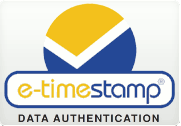Subscriptions and Archive
A directory of FAQ's on other subjects is here.
Subscriptions
Your subscription provides a steady supply of timestamps and access to the DigiStamp Archive. We tie the two together because the Archive is an ongoing effort to add additional protection to your timestamps.
Your current subscription only covers Archive access for timestamps made within it. If you cancel your subscription and later start a new subscription, you only have Archive access for timestamps created in the latest subscription. Canceling your subscription permanently separates you from subscriber Archive access to timestamps made under that subscription.
The smallest subscription you can select is 25% of the largest subscription you have used. We recommend purchashing additional timestamp credits directly for periods of unusually high volume.
We continuously add protection to timestamps in the archive, and so you must keep a proportional subscription to access the archive.
Your subscription aims to give you a steady and appropriate supply of timestamps. At the end of your subscription's interval, such as 90 or 30 days; your balance is reset to your subscribed amount. However, we allow you to keep some unused credits in case you will use more during the next interval.
This is why your account statement will show your current balance, and the new balance you will have after your renewal date. If you will lose some credits, the statement tries to make this clear for you as well.
As an example, let's consider an example user's statement:
The available balance for your account is 17 timestamps.
Remember! your balance will be set to 45 on 2014-09-23. If it happened today, you would lose 2 unused timestamp credits.
You will receive 30 timestamps from your subscription, and rollover 15 timestamps from the prior month.
At renewal, their subscription will rollover 15 of their 17 unused credits, and add 30 new ones. The two credits in excess of the 15 allowed to rollover are lost.
Yes, but the costs are unfavorable. We want to ensure steady support of the Archive so that it can protect users now and long into the future. For this reason, our pricing for timestamp download and evidence records outside of subscriptions will always be unfavorable.
In this first release, non-subscription prices for Archive functions have not been set and are not currently automated. Expect to negotiate with us on a case-by-case basis.
The DigiStamp Archive
The Archive provides two functions to our users:
Easy Re-Download of Timsetamps
Subscribers may download timestamps created with their subscription at a later time.
Perpetual Protection
DigiStamp stays abreast of new and improving cryptographic methods; both in favor of our users and those that may one day harm the integrity of our timestamps. The archive allows us to add new, improved protection to all of the timestamps we create. We provide this improved protection to subscribers in the form of an Evidence Record (ER), available for any timestamp covered by an active DigiStamp Subscription. This Archive function is an implementation of the IETF's RFC 6283: XMLERS.
The DigiStamp Archive stores your protected hash values and the timestamps we create for them. The Archive itself is then protected with cryptography similar to the protection the timestamp offers your protected hash value. In this way, the Archive itself is tamper-evident and could be used to prove the integrity of your data indendently of the original timestamp.
Furthermore, the methods employed allow us to renew your timestamps by renewing the Archive. Although our use of strong cryptography for the timestamping service means the problem this prevents probably will not occur before 2030, the Archive allows us to retroactively protect timestamps you make today with the best signature algorithms of the future.
The Archive allows us to protect you now, and later.
The evidence record you download contains a series of hash values and a timestamp signature. The hash of your timestamp can be found in Sequence Order 1. By concatenating this value with its sibling in Order 1 and hashing the result, you can find their contributions to Sequence Order 2. Perform this operation repeatedly, noting that they must be ordered in binary ascending while concatenating, until you are left with the root hash value. This hash value is protected by the timestamp found in the field TimeStampToken.

The basis of these methods, and the syntax of the Evidence Records we provide, are described in the IETF's RFC 6283: XMLERS.
